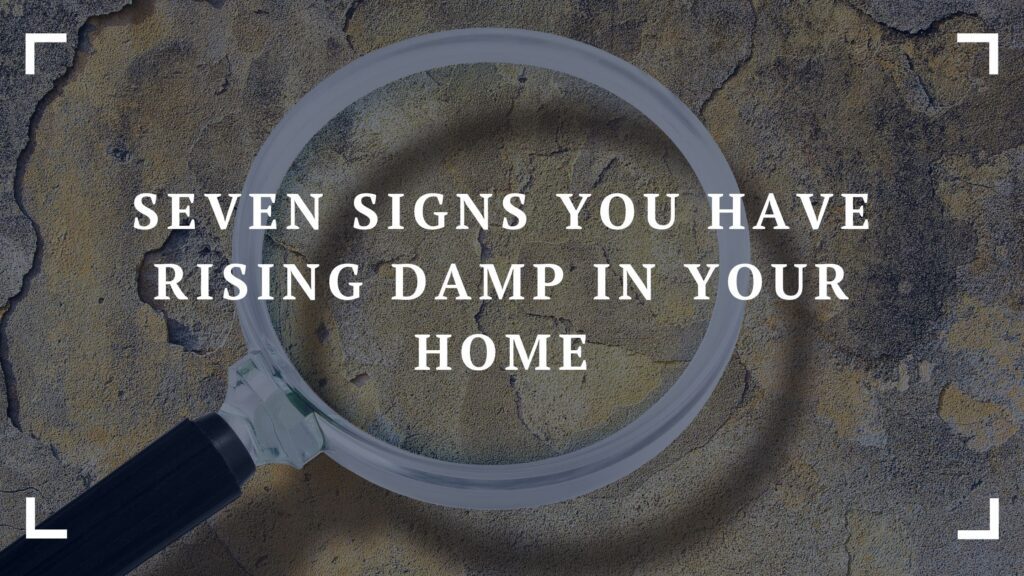One of the most annoying property issues homeowners can experience is rising damp. In addition to being unpleasant, it can affect health conditions, spoil your décor, and even harm the building’s structural strength. Furthermore, persistent damp problems can dramatically reduce the value of your house, so it’s essential to look after them as soon as they arise.
The UK doesn’t experience rising damp very often, which is good news. The bad news is that it’s frequently ignored because it’s sometimes misunderstood for other types of moisture. So how exactly can you get rid of rising damp, and what does it look like in reality?
The reasons for growing damp and the warning indications of rising damp in your home are discussed in this blog post. Additionally, we’ll show you how to deal with rising damp effectively.

1. Walls With Tidemarks and Damp Stains
If your walls have tidemarks, that is one of the most obvious rising damp signs. On interior walls, they will appear as horizontal brown or discolored stains around a meter high.
These tidemarks result from salt migrations caused by evaporated moisture that has moved up the walls from the floor. If no tidemarks are visible, moisture on the walls could be another indicator.
They will be brown and 1 meter above the earth, just like the tidemarks. But instead, rising damp may cause these moist areas to be more than one meter off the ground.
2. Musty Smell
You might notice a musty odour in your home, one of the most typical signs of dampness. It has a musky, moist fragrance that indicates a damp problem. However, it might be challenging to determine which type of moisture is the problem because they all have a musty smell.
3. Wet Patches On Walls
It’s probably rising damp if damp or wet areas are on your walls. These patches must be located between the lower parts of the wall and the building’s ground level for rising damp to occur.
Moisture moves up walls via the brick and stones in a capillary motion that causes rising damp. A damp-proof course is a primary method of preventing rising damp; if it is broken or doesn’t exist, your property is susceptible to rising damp. If the building’s ground floor is above your damp problem, then other damp problems are to blame.
4. Peeling Wallpaper
Wallpaper peeling is a crucial indicator that rising damp is taking place. The walls will be completely moist if the house has been damp for a long time. Therefore, the likelihood that the wallpaper may begin to peel off the wall increases with the amount of moisture in the building.
This is probably on the lower portions of the wall or near the skirting board. Peeling paper can also indicate issues with penetrating damp or condensation. Therefore you should have a damp proofing expert conduct a survey to ensure a proper diagnosis is made.
5. Plaster That Is Flaking Or Bubbling
Plaster that is flaky or bubbling is frequently a sign of rising damp. The plaster will probably be falling apart, or there will be plaster deposits on the floor. This results from the quantity of moisture in the walls, which weakens the plaster until it eventually falls off over time.
Many UK homeowners are obviously distressed by this issue because it does not appear aesthetically attractive and may also be expensive to remedy.
6. Wooden Beading and Skirting Boards Start to Rot
It would be best to handle rising damp as soon as it is discovered because long-term neglect might result in catastrophic issues. Your skirting boards, for instance, can start to decay.
This is because rot begins to spread when the moisture content in the wood reaches 20%. Therefore, before enabling rotting fungi to take root, homeowners must be conscious of this and prevent the source of the damp problem.
7. Developing Black Mould On Walls
A classic indicator of a property’s moisture issue is black mould on the walls. Black mould is frequently linked to condensation, but if the mould grows in one area of the wall, it may indicate that you’re dealing with a rising damp issue.
A damp surveyor would need to look into this further to determine what kind of issue is causing the black mould to develop on the walls.
Treating Rising Damp
It’s time to eliminate rising damp from your property once you’ve detected it. It may be tempting to order a humidifier immediately, but you must first identify the cause to move on to the solution. This will ensure you’re treating rising damp correctly, so it doesn’t become a recurring issue.
Your surveyor might advise installing a brand-new DPC, which includes pumping chemicals into the building to create a water-resistant barrier for more severe cases of rising damp. Although this is a costly solution, it is undoubtedly the best way to treat (and avoid) increasing damp. A cavity tray may also need to be installed or updated, which is something that should only be done by a professional. This prevents water from the building’s exterior from accessing the interior wall.
First, a professional must make a proper diagnosis because there might be a more serious problem. This could be a certified rising damp specialist or damp surveyor. Then, an expert will make a recommendation for the best line of action after their analysis.


